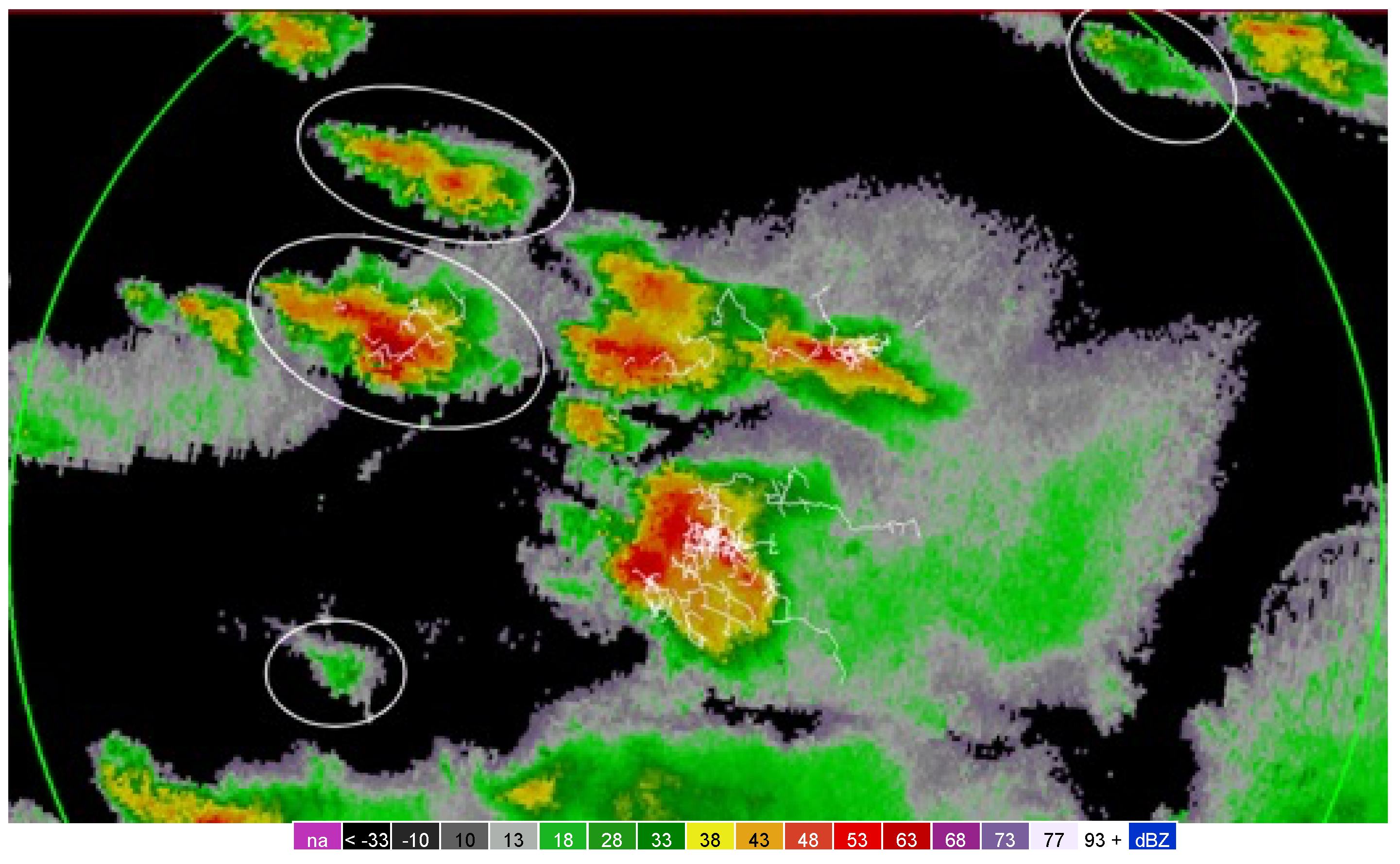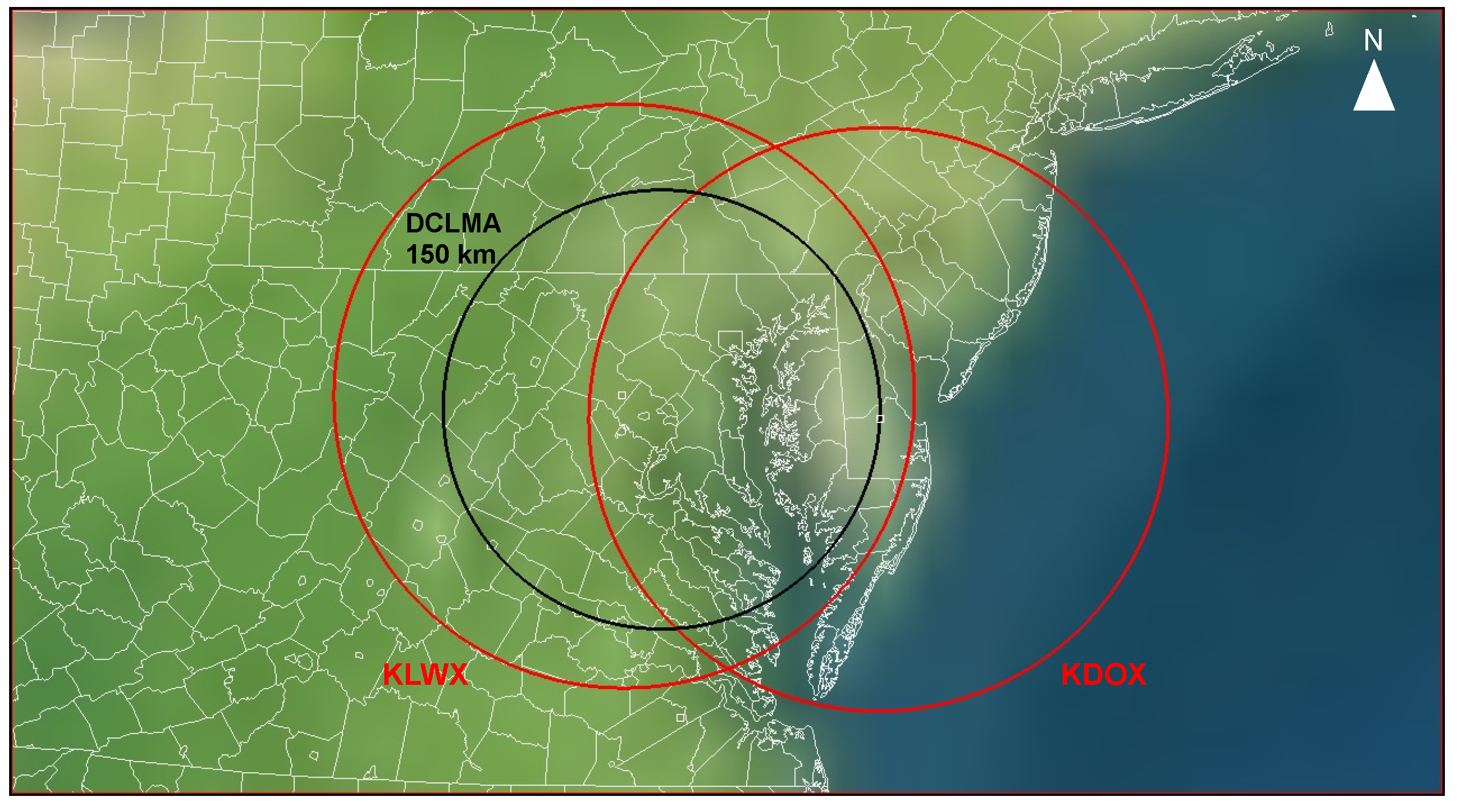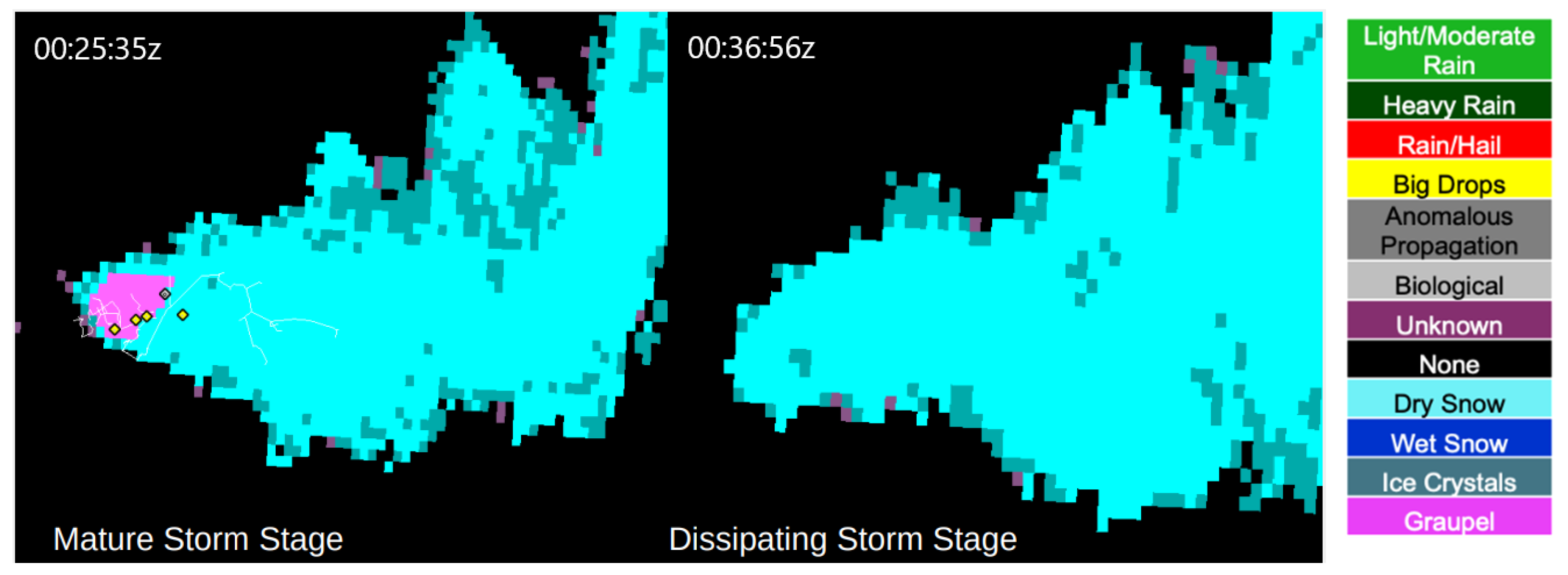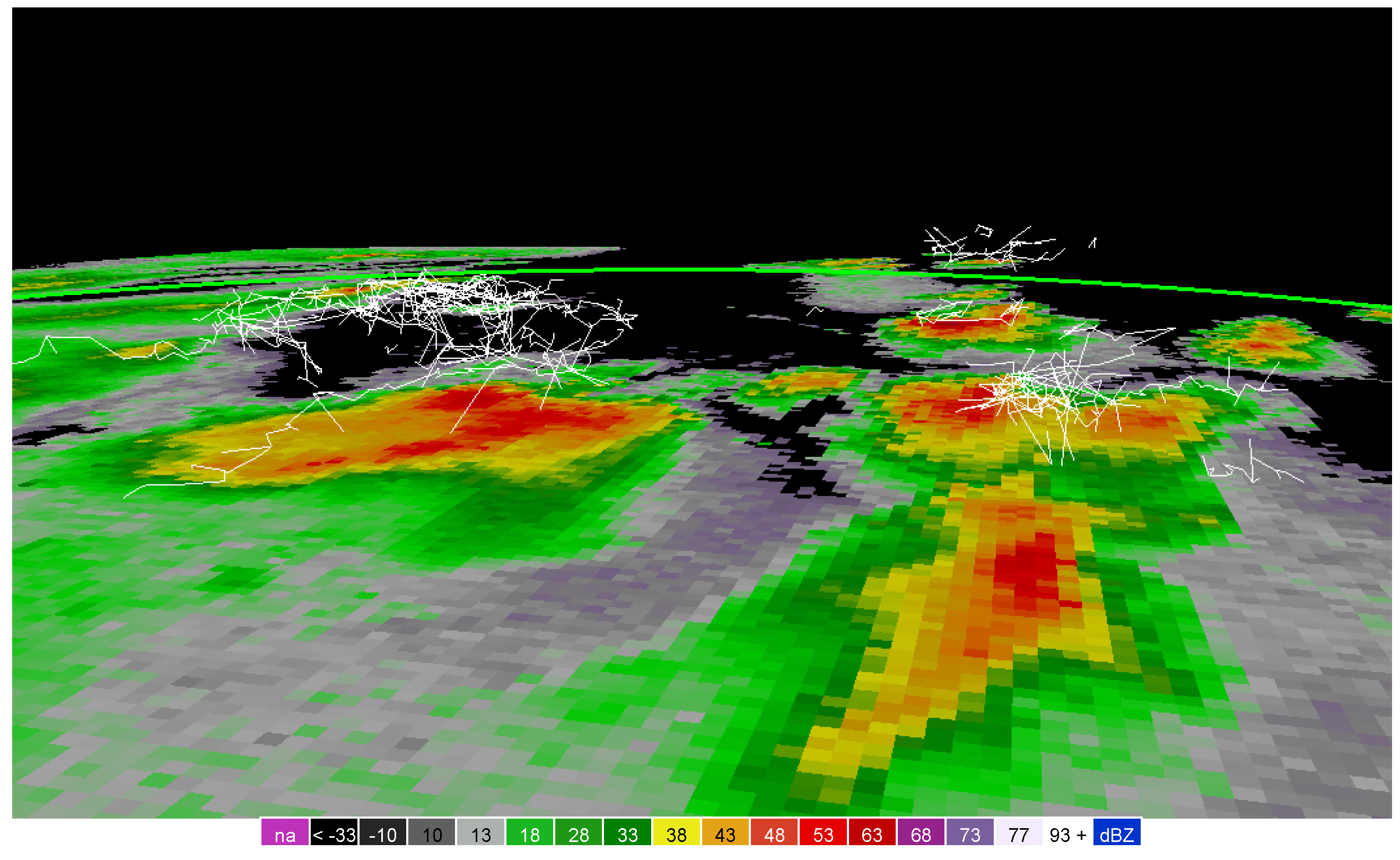Lightning Cessation Guidance Using Polarimetric Radar Data and Lightning Mapping Array in the Washington, D.C. Area
Abstract
:1. Introduction
2. Data and Methods
2.1. Lightning Data
2.2. Radar and Environmental Data
2.3. Lightning Flash Algorithm
2.4. Simulating Case Studies
- 1.
- ZH ≥ 40 dBZ
- 2.
- ZH ≥ 35 dBZ
- 3.
- presence of graupel
- 4.
- presence of graupel with ZH ≥ 40 dBZ
- 5.
- presence of graupel with ZH ≥ 35 dBZ
3. Results and Conclusions
Author Contributions
Funding
Institutional Review Board Statement
Informed Consent Statement
Data Availability Statement
Conflicts of Interest
References
- National Oceanic and Atmospheric Administration. Lightning. NOAA. 2014. Available online: https://www.weather.gov/media/owlie/lightning3_050714.pdf (accessed on 15 November 2021).
- Steiner, M.; Deierling, W.; Ikeda, K.; Bass, R.G. Ground delays from lightning ramp closures and decision uncertainties. Air Traffic Control Quart. 2014, 22, 223–249. [Google Scholar] [CrossRef]
- Holle, R.L.; Watson, A.I.; Lopez, R.E.; Howard, K.W.; Ortiz, R.; Li, L. Meteorological Studies to Improve Short Range. Forecasting of Lightning/Thunderstorms within the Kennedy Space Center Area Final Report; National Severe Storms Laboratory: Boulder, CO, USA, 1992; 91p, Available from R. Holle, National Severe Storms Laboratory, 1313 Halley Circle, Norman, OK 73069. [Google Scholar]
- Holle, R.L.; Lopez, R.E.; Zimmermann, C. Updated recommendations for lightning safety—1998. Bull. Am. Meteorol. Soc. 1999, 80, 2035–2041. [Google Scholar] [CrossRef] [Green Version]
- Preston, A.D.; Fuelberg, H.E. Improving lightning cessation guidance using polarimetric radar data. Weather. Forecast. 2015, 30, 308–328. [Google Scholar] [CrossRef]
- Rakov, V.A.; Uman, M.A. Lightning: Physics and Effects; Cambridge University Press: Cambridge, MA, USA, 2003; 701p. [Google Scholar]
- Rakov, V.A. Fundamentals of Lightning; Cambridge University Press: Cambridge, MA, USA, 2016; 271p. [Google Scholar]
- Takahashi, T. Riming electrification as a charge generation mechanism in thunderstorms. J. Atmos. Sci. 1978, 35, 1536–1548. [Google Scholar] [CrossRef]
- Zhang, R.; Williams, E.R.; Rydock, J. Mixed-phase microphysics and cloud electrification. J. Atmos. Sci. 1991, 48, 2195–2203. [Google Scholar] [CrossRef]
- Jayaratne, E.R.; Saunders, C.P.R.; Hallett, J. Laboratory studies of the charging of soft-hail during ice crystal interactions. Q. J. R. Meteorol. Soc. 1983, 109, 609–630. [Google Scholar] [CrossRef]
- Williams, E.R. The tripole structure of thunderstorms. J. Geophys. Res. 1989, 94, 13151–13167. [Google Scholar] [CrossRef]
- Rakov, V.A. The physics of lightning. Surv. Geophys. 2013, 34, 701–729. [Google Scholar] [CrossRef]
- Davey, M.J.; Fuelberg, H.E. Using radar-derived parameters to forecast lightning cessation for nonisolated storms. J. Geophys. Res. Atmos. 2017, 122, 3435–3456. [Google Scholar] [CrossRef]
- Carey, L.D.; Petersen, W.A.; Deierling, W.K. Radar differential phase signatures of ice orientation for the prediction of lightning initiation and cessation. In Proceedings of the 34th Conference on Radar Meteorology, Williamsburg, VA, USA, 5–9 October 2009. [Google Scholar]
- Schultz, E.V.; Stano, G.T.; Carey, L.D.; Petersen, W.A. Radar applications for nowcasting lightning cessation. In Proceedings of the Sixth Conference on the Meteorological Applications of Lightning Data, Austin, TX, USA, 5–7 January 2013; Available online: https://ams.confex.com/ams/93Annual/webprogram/Paper220563.html (accessed on 15 November 2021).
- Seroka, G.N.; Orville, R.E.; Schumacher, C. Radar nowcasting of total lightning over the Kennedy Space Center. Weather Forecast. 2012, 27, 189–204. [Google Scholar] [CrossRef] [Green Version]
- Stano, G.T.; Fuelberg, H.E.; Roeder, W.P. Developing an empirical lightning cessation forecast guidance for the Kennedy Space Center. J. Geophys. Res. 2010, 115, D09205. [Google Scholar] [CrossRef] [Green Version]
- Holden, N. Forecasting Lightning Cessation Using Dual-Polarization Radar and Lightning Mapping Array Near Washington, D.C. Master’s Thesis, Air Force Institute of Technology, Dayton, OH, USA, 2018. Available online: https://scholar.afit.edu/etd/1750 (accessed on 15 November 2021).
- Patton, J.R.; Fuelberg, H.E. Using radar-derived parameters to develop probabilstic guidance for lightning cessation within isolated convection near Cape Canaveral, Florida. Weather Forecast. 2019, 34, 559–575. [Google Scholar] [CrossRef]
- Williams, E.R.; Mushtak, V.; Rosenfield, D.; Goodman, S.; Boccippio, D. Thermodynamic conditions favorable to superlative thunderstorm updraft, mixed phase microphysics and lightning flash rate. Atmos. Res. 2005, 76, 288–306. [Google Scholar] [CrossRef]
- Zhang, Y.; Guo, Y. Variability of atmospheric freezing-level height and its impact on the cryosphere in China. Ann. Glaciol. 2011, 52, 81–88. [Google Scholar] [CrossRef] [Green Version]
- Simpson, J.E. Sea Breeze and Local Winds; Cambridge University Press: Cambridge, MA, USA, 1994. [Google Scholar]
- Pokharel, B.; Wang, S.Y.S.; Meyer, J.; Gillies, R.; Lin, Y.H. Climate of the weakly-forced yet high-impact convective storms throughout the Ohio River Valley and Mid-Atlantic United States. Clim. Dyn. 2019, 52, 5709–5721. [Google Scholar] [CrossRef] [Green Version]
- Krehbiel, P.; Thomas, R.; Rison, W.; Hamlin, T.; Harlin, J.; Davis, M. GPS-based mapping systems reveals lightning inside storms. Earth Space Sci. News 2000, 81, 21–25. [Google Scholar] [CrossRef]
- Rison, W.; Thomas, R.J.; Krehbiel, P.R.; Hamlin, T.; Harlin, J. A GPS-based three-dimensional lightning mapping system: Initial observations in central New Mexico. Geophys. Res. Lett. 1999, 26, 3573–3576. [Google Scholar] [CrossRef] [Green Version]
- Lakshmanan, V.; Smith, T.; Hondl, K.; Stumpf, G.J. The Warning Decision Support System–Integrated Information (WDSS−II). Weather Forecast. 2007, 22, 596–612. [Google Scholar] [CrossRef]
- Chmielewski, V.C.; Bruning, E.C. Lightning Mapping Array flash detection performance with variable receiver thresholds. J. Geophys. Res. Atmos. 2016, 121, 8600–8614. [Google Scholar] [CrossRef]
- Benjamin, S.G.; Sahm, S. Rapid Refresh (RAP). 2012. Available online: http://rapidrefresh.noaa.gov (accessed on 15 November 2021).
- Park, H.S.; Ryzhkov, A.V.; Zrnic, D.S.; Kim, K.-E. The hydrometeor classification algorithm for the polarimetric WSR-88D: Description and application to an MCS. Weather Forecast. 2009, 24, 730–748. [Google Scholar] [CrossRef]
- Ryzhkov, A.V.; Schuur, T.J.; Burgess, D.W.; Heinselman, P.L.; Griangrade, S.E.; Zrnic, D.S. The Joint Polarization Experiment: Polarimetric rainfall measurements and hydrometeor classification. Bull. Am. Meteorol. Soc. 2005, 86, 809–824. [Google Scholar] [CrossRef] [Green Version]
- Schuur, T.J.; Ryzhkov, A.; Heinselman, P.; Zrnic, D.; Burgess, D.; Scharfenberg, K. Observation and Classification of Echoes with the Polarimetric WSR-88D Radar; National Severe Storms Laboratory Report; National Severe Storms Laboratory: Norman, OK, USA, 2003; 46p. [Google Scholar]
- Grazioli, J.; Tuia, D.; Berne, A. Hydrometeor classification from polarimetric radar measurements: A clustering approach. Atmos. Meas. Tech. 2015, 8, 149–170. [Google Scholar] [CrossRef] [Green Version]
- MacGorman, D.R.; Rust, W.D.; Schuur, T.J.; Biggerstaff, M.I.; Straka, J.M.; Ziegler, C.L.; Mansell, E.R.; Bruning, E.C.; Kuhlman, K.M.; Lund, N.R.; et al. TELEX: The Thunderstorm Electrification and Lightning Experiment. Bull. Am. Meteorol. Soc. 2008, 89, 997–1013. [Google Scholar] [CrossRef]
- Rudlosky, S.D.; Fuelberg, H.E. Documenting Storm Severity in the Mid-Atlantic Region Using Lightning and Radar Information. Mon. Weather Rev. 2013, 41, 3186–3202. [Google Scholar] [CrossRef]
- Johnson, J.T.; MacKeen, P.L.; Witt, A.; Mitchell, E.D.; Stumpf, G.J.; Eilts, M.D.; Thomas, K.W. The Storm Cell Identification and Tracking algorithm: An enhanced WSR-88D algorithm. Weather Forecast. 1998, 13, 263–276. [Google Scholar] [CrossRef] [Green Version]




| Lightning Ended | Lightning Ongoing | |
|---|---|---|
| Advisory Ended | Hit | False Alarm |
| Advisory Ongoing | Miss | Null |
| Temp Level (oC) | Wait Time | dBZ ≥ 40 | dBZ ≥ 35 | Graupel | Graupel + dBZ ≥ 40 | Graupel + dBZ ≥ 35 |
|---|---|---|---|---|---|---|
| 0 | 5 min | 1.00 | 1.00 | 1.00 | 1.00 | 1.00 |
| 10 min | 1.00 | 1.00 | 1.00 | 1.00 | 1.00 | |
| 15 min | 1.00 | 1.00 | 1.00 | 1.00 | 1.00 | |
| −5 | 5 min | 1.00 | 1.00 | 1.00 | 1.00 | 1.00 |
| 10 min | 1.00 | 1.00 | 1.00 | 1.00 | 1.00 | |
| 15 min | 1.00 | 1.00 | 1.00 | 1.00 | 1.00 | |
| −10 | 5 min | 1.00 | 1.00 | 1.00 | 1.00 | 1.00 |
| 10 min | 1.00 | 1.00 | 1.00 | 1.00 | 1.00 | |
| 15 min | 1.00 | 1.00 | 1.00 | 1.00 | 1.00 | |
| −15 | 5 min | 0.94 | 1.00 | 1.00 | 1.00 | 1.00 |
| 10 min | 0.95 | 1.00 | 1.00 | 1.00 | 1.00 | |
| 15 min | 0.95 | 1.00 | 1.00 | 1.00 | 1.00 | |
| −20 | 5 min | 0.86 | 1.00 | 1.00 | 1.00 | 1.00 |
| 10 min | 0.89 | 1.00 | 1.00 | 1.00 | 1.00 | |
| 15 min | 0.90 | 1.00 | 1.00 | 1.00 | 1.00 |
| Temp Level (oC) | Wait Time | dBZ ≥ 40 | dBZ ≥ 35 | Graupel | Graupel + dBZ ≥ 40 | Graupel + dBZ ≥ 35 |
|---|---|---|---|---|---|---|
| 0 | 5 min | 0.04 | 0.00 | 0.00 | 0.00 | 0.00 |
| 10 min | 0.00 | 0.00 | 0.00 | 0.00 | 0.00 | |
| 15 min | 0.00 | 0.00 | 0.00 | 0.00 | 0.00 | |
| −5 | 5 min | 0.00 | 0.00 | 0.00 | 0.00 | 0.00 |
| 10 min | 0.00 | 0.00 | 0.00 | 0.00 | 0.00 | |
| 15 min | 0.00 | 0.00 | 0.00 | 0.00 | 0.00 | |
| −10 | 5 min | 0.13 | 0.04 | 0.04 | 0.04 | 0.04 |
| 10 min | 0.13 | 0.00 | 0.00 | 0.00 | 0.00 | |
| 15 min | 0.04 | 0.00 | 0.00 | 0.00 | 0.00 | |
| −15 | 5 min | 0.23 | 0.04 | 0.04 | 0.04 | 0.04 |
| 10 min | 0.09 | 0.04 | 0.00 | 0.00 | 0.00 | |
| 15 min | 0.05 | 0.00 | 0.00 | 0.00 | 0.00 | |
| −20 | 5 min | 0.43 | 0.13 | 0.09 | 0.09 | 0.09 |
| 10 min | 0.19 | 0.04 | 0.09 | 0.04 | 0.04 | |
| 15 min | 0.10 | 0.00 | 0.04 | 0.00 | 0.00 |
| Temp Level (oC) | Wait Time | dBZ ≥ 40 | dBZ ≥ 35 | Graupel | Graupel + dBZ ≥ 40 | Graupel + dBZ ≥ 35 |
|---|---|---|---|---|---|---|
| 0 | 5 min | 0.96 | 1.00 | 1.00 | 1.00 | 1.00 |
| 10 min | 1.00 | 1.00 | 1.00 | 1.00 | 1.00 | |
| 15 min | 1.00 | 1.00 | 1.00 | 1.00 | 1.00 | |
| −5 | 5 min | 1.00 | 1.00 | 1.00 | 1.00 | 1.00 |
| 10 min | 1.00 | 1.00 | 1.00 | 1.00 | 1.00 | |
| 15 min | 1.00 | 1.00 | 1.00 | 1.00 | 1.00 | |
| −10 | 5 min | 0.87 | 0.96 | 0.96 | 0.96 | 0.96 |
| 10 min | 0.87 | 1.00 | 1.00 | 1.00 | 1.00 | |
| 15 min | 0.96 | 1.00 | 1.00 | 1.00 | 1.00 | |
| −15 | 5 min | 0.74 | 0.96 | 0.96 | 0.96 | 0.96 |
| 10 min | 0.87 | 0.96 | 1.00 | 1.00 | 1.00 | |
| 15 min | 0.91 | 1.00 | 1.00 | 1.00 | 1.00 | |
| −20 | 5 min | 0.52 | 0.87 | 0.91 | 0.91 | 0.91 |
| 10 min | 0.74 | 0.96 | 0.91 | 0.96 | 0.96 | |
| 15 min | 0.83 | 1.00 | 0.96 | 1.00 | 1.00 |
| Temp Level (oC) | Wait Time | dBZ ≥ 40 | dBZ ≥ 35 | Graupel | Graupel + dBZ ≥ 40 | Graupel + dBZ ≥ 35 |
|---|---|---|---|---|---|---|
| 0 | 5 min | 4–46 (21) | 4–51 (25) | 4–51 (25) | 4–51 (25) | |
| 10 min | 5–47 (21) | 9–82 (29) | 9–56 (30) | 9–56 (30) | 9–82 (33) | |
| 15 min | 10–52 (26) | 14–87 (34) | 14–61 (35) | 14–61 (35) | 14–87 (38) | |
| −5 | 5 min | 1–35 (14) | 4–44 (18) | 4–39 (19) | 4–39 (19) | 4–44 (20) |
| 10 min | 6–40 (19) | 9–82 (25) | 9–44 (24) | 9–44 (24) | 9–82 (27) | |
| 15 min | 11–45 (24) | 14–87 (30) | 14–49 (29) | 14–49 (29) | 14–87 (32) | |
| −10 | 5 min | |||||
| 10 min | 5–39 (19) | 5–44 (23) | 5–44 (23) | 5–44 (23) | ||
| 15 min | 10–44 (24) | 10–49 (28) | 10–49 (30) | 10–49 (28) | ||
| −15 | 5 min | |||||
| 10 min | 5–33 (19) | 5–33 (19) | 5–41 (20) | |||
| 15 min | 5–46 (23) | 10–38 (24) | 10–83 (27) | 10–46 (25) | ||
| −20 | 5 min | |||||
| 10 min | ||||||
| 15 min | 4–83 (20) | 5–37 (20) | 5–83 (23) |
Publisher’s Note: MDPI stays neutral with regard to jurisdictional claims in published maps and institutional affiliations. |
© 2022 by the authors. Licensee MDPI, Basel, Switzerland. This article is an open access article distributed under the terms and conditions of the Creative Commons Attribution (CC BY) license (https://creativecommons.org/licenses/by/4.0/).
Share and Cite
Drugan, J.J.; Preston, A.D. Lightning Cessation Guidance Using Polarimetric Radar Data and Lightning Mapping Array in the Washington, D.C. Area. Atmosphere 2022, 13, 1111. https://doi.org/10.3390/atmos13071111
Drugan JJ, Preston AD. Lightning Cessation Guidance Using Polarimetric Radar Data and Lightning Mapping Array in the Washington, D.C. Area. Atmosphere. 2022; 13(7):1111. https://doi.org/10.3390/atmos13071111
Chicago/Turabian StyleDrugan, John J., and Ari D. Preston. 2022. "Lightning Cessation Guidance Using Polarimetric Radar Data and Lightning Mapping Array in the Washington, D.C. Area" Atmosphere 13, no. 7: 1111. https://doi.org/10.3390/atmos13071111
APA StyleDrugan, J. J., & Preston, A. D. (2022). Lightning Cessation Guidance Using Polarimetric Radar Data and Lightning Mapping Array in the Washington, D.C. Area. Atmosphere, 13(7), 1111. https://doi.org/10.3390/atmos13071111






